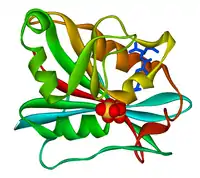Antifolate
Antifolates are a class of antimetabolite medications that antagonise (that is, block) the actions of folic acid (vitamin B9).[1] Folic acid's primary function in the body is as a cofactor to various methyltransferases involved in serine, methionine, thymidine and purine biosynthesis. Consequently, antifolates inhibit cell division, DNA/RNA synthesis and repair and protein synthesis. Some such as proguanil, pyrimethamine and trimethoprim selectively inhibit folate's actions in microbial organisms such as bacteria, protozoa and fungi. The majority of antifolates work by inhibiting dihydrofolate reductase (DHFR).[2]
 Dihydrofolate reductase (DHFR) |  Folic acid |
Comparison of available agents
| Drug | Class | Pharmacologic target | Myelosuppressive effect | US pregnancy category | Indications | Notable adverse effects |
|---|---|---|---|---|---|---|
| Methotrexate[3] | Antineoplastic & immunosuppressant | Mammalian DHFR | +++ | X | Malignancies (esp. haematologic malignancies and osteosarcoma), ectopic pregnancy and autoimmune conditions (esp. rheumatoid arthritis, psoriasis, Granulomatosis with polyangiitis, Goodpasture syndrome, etc.) | Kidney or liver failure, Stevens–Johnson syndrome, toxic epidermal necrolysis, infection, aplastic anaemia, opportunistic infections and GI effects. |
| Pemetrexed[4] | Antineoplastic | Mammalian DHFR, TS, GARFT | +++ | D | Non-small cell lung carcinoma & mesothelioma | Nausea, vomiting, dyspnoea, constipation, chest pain, diarrhoea, weight loss, stomatitis, rash, fever, peripheral neuropathy, dehydration, kidney failure, Stevens–Johnson syndrome, toxic epidermal necrolysis and erythema multiforme. |
| Proguanil[5] | Antimalarial | Protozoal DHFR | +/- | C | Malaria, prevention and treatment | Abdominal pain, headaches, increased LFTs, myalgia, nausea, opportunistic infections, diarrhoea, vomiting, etc. Less commonly Stevens–Johnson syndrome, toxic epidermal necrolysis, agranulocytosis, liver failure, anaphylaxis, etc. |
| Pyrimethamine[6] | Antiprotozoal | Protozoal DHFR | +/- | C | Malaria, toxoplasmosis and pneumocystis jiroveci pneumonia. | Stevens–Johnson syndrome, toxic epidermal necrolysis, agranulocytosis and aplastic anaemia. |
| Trimethoprim[7] | Broad-spectrum antimicrobial | Microbial DHFR | +/- | C | Numerous (especially when in combination with the sulfonamide, sulfamethoxazole); treatment & prophylaxis for pneumocystis jiroveci pneumonia, malaria and toxoplasmosis. Treatment of melioidosis, shigellosis, listeria, urinary tract infections, acute infectious exacerbations of chronic bronchitis, infection prophylaxis in HIV-positive individuals, cyclospora protozoa, etc. | Stevens–Johnson syndrome, toxic epidermal necrolysis, agranulocytosis and aplastic anaemia. |
Mechanism
Many are primarily DHFR inhibitors, but raltitrexed is an inhibitor of thymidylate synthase, and pemetrexed inhibits both and a third enzyme.
Antifolates act specifically during DNA and RNA synthesis, and thus are cytotoxic during the S-phase of the cell cycle. Thus, they have a greater toxic effect on rapidly dividing cells (such as malignant and myeloid cells, and GI & oral mucosa), which replicate their DNA more frequently, and thus inhibits the growth and proliferation of these non-cancerous cells as well as causing the side-effects listed.
Limitations
Side-effects
The antifolate action specifically targets the fast-dividing cells, and tend to have adverse effects on the bone marrow, skin, and hair. As folate is vital in the first trimester of pregnancy for healthy fetal development, the use of antifolates is strongly contraindicated in pregnancy and carries significant teratogenic risk.
Low doses of methotrexate can deplete folate stores and cause side-effects that are similar to folate deficiency. Both high-folate diets and supplemental folic acid may help reduce the toxic side-effects of low-dose methotrexate without decreasing its effectiveness.[8][9] Anyone taking low-dose methotrexate for the health problems listed above should consult with a physician about the need for a folic acid supplement.
Resistance
While the role of folate as a cancer treatment is well established, its long-term effectiveness is diminished by cellular response. In response to decreased tetrahydrofolate (THF), the cell begins to transcribe more DHF reductase, the enzyme that reduces DHF to THF. Because methotrexate is a competitive inhibitor of DHF reductase, increased concentrations of DHF reductase can overcome the drugs inhibition.
Many new drugs are under development to reduce antifolate drug resistance.[10][11]
Drugs that incidentally antagonize folate
The name antifolate usually refers to drugs whose folate antagonism is intentional. In contrast, there are some other drugs, of several drug classes, that antagonize folate incidentally, as an adverse effect, whether mildly or heavily. This effect is often not noticeable except when it causes a neural tube defect in a fetus carried by a woman taking the medication. Such drugs include some anticonvulsants (valproic acid, carbamazepine, phenobarbital, phenytoin, and primidone) and trimethoprim. Lamotrigine is also an anticonvulsant with known (from in vitro testing) weak anti-folate effects.[12]
See also
- Sulfonamides, a class of antimicrobials that work by inhibiting folate biosynthesis.
References
- "NCI: antifolate".
- Ivan M. Kompis, Khalid Islam, Rudolf L. Then (2005). "DNA and RNA Synthesis: Antifolates". Chem. Rev. 105 (2): 593–620. doi:10.1021/cr0301144. PMID 15700958.
{{cite journal}}: CS1 maint: uses authors parameter (link) - "Trexall, Rheumatrex (methotrexate) dosing, indications, interactions, adverse effects, and more". Medscape Reference. WebMD. Retrieved 10 January 2014.
- "Alimta (pemetrexed) dosing, indications, interactions, adverse effects, and more". Medscape Reference. WebMD. 10 January 2014.
- "Paludrine (proguanil) dosing, indications, interactions, adverse effects, and more". Medscape Reference. WebMD. Retrieved 10 January 2014.
- "Daraprim (pyrimethamine) dosing, indications, interactions, adverse effects, and more". Medscape Reference. WebMD. Retrieved 12 January 2014.
- "Primsol, Proloprim (trimethoprim) dosing, indications, interactions, adverse effects, and more". Medscape Reference. WebMD. Retrieved 10 January 2014.
- Morgan SL, Baggott JE, Alarcon GS (1997). "Methotrexate in rheumatoid arthritis: folate supplementation should always be given". BioDrugs. 8 (1): 164–75. doi:10.2165/00063030-199708030-00002. PMID 18020507. S2CID 26003509.
- Morgan SL, Baggott JE, Lee JY, Alarcon GS (1998). "Folic acid supplementation prevents deficient blood folate levels and hyperhomocysteinemia during long-term, low-dose methotrexate therapy for rheumatoid arthritis: Implications for cardiovascular disease prevention". Journal of Rheumatology. 25 (3): 441–6. PMID 9517760.
- Takimoto CH (1996). "New Antifolates: Pharmacology and Clinical Applications". Oncologist. 1 (1 & 2): 68–81. doi:10.1634/theoncologist.1-1-68. PMID 10387971.
- Gangjee A, Jain HD, Kurup S (September 2007). "Recent advances in classical and non-classical antifolates as antitumor and antiopportunistic infection agents: part I". Anti-Cancer Agents Med Chem. 7 (5): 524–42. doi:10.2174/187152007781668724. PMID 17896913. Archived from the original on 2013-04-14.
- Brunton, Laurence (2011). Goodman & Gilman's pharmacological basis of therapeutics (12th ed.). New York: McGraw-Hill. ISBN 978-0071624428.
External links
- Antifolates at the US National Library of Medicine Medical Subject Headings (MeSH)

